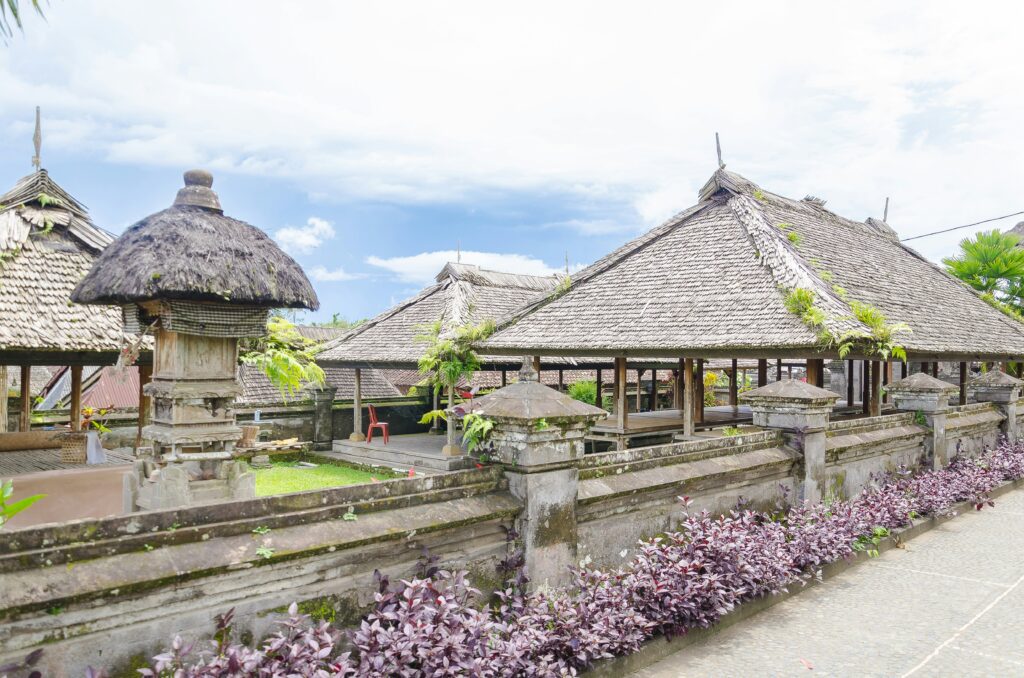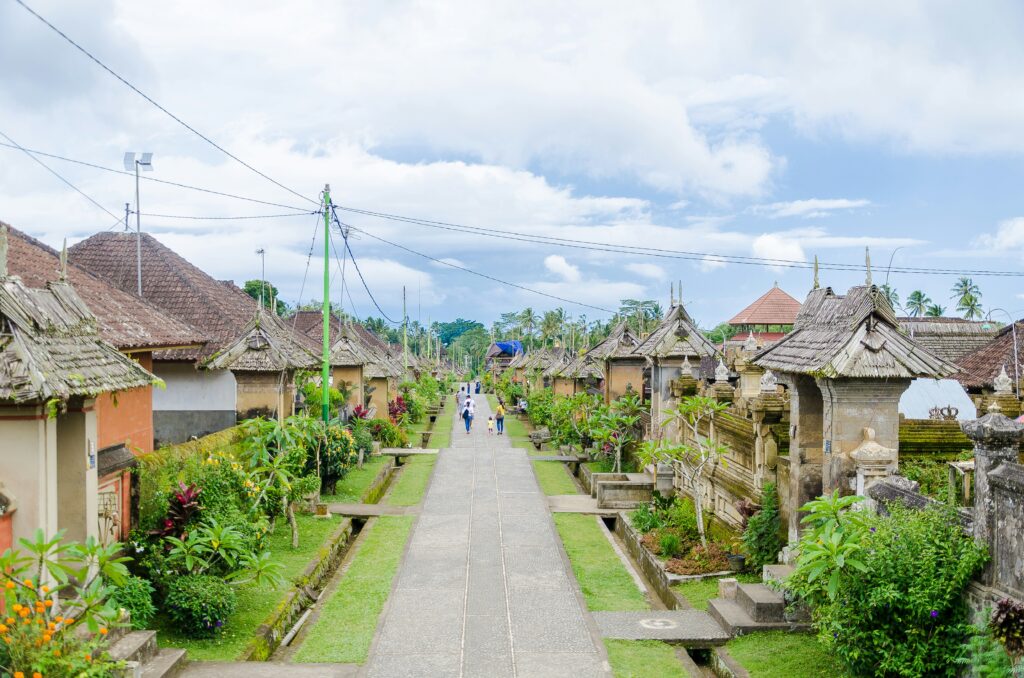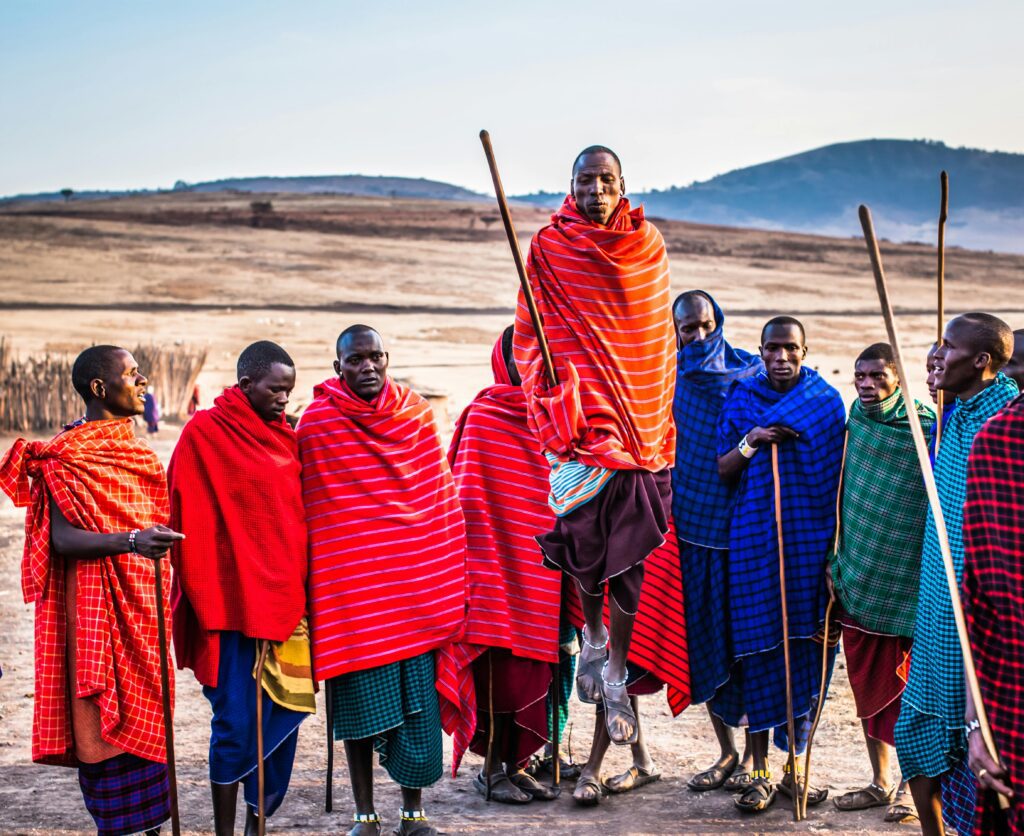This comprehensive Penglipuran Travel Guide will give you practical advice to enhance your trip. Plan your adventure now & experience the best of Penglipuran!
Introduction: Step into Bali’s Timeless Village
As I walked down Penglipuran’s immaculate stone pathway, the scent of frangipani blossoms mingled with the earthy aroma of bamboo. The village, nestled in Bali’s Bangli Regency, is a living museum where tradition thrives. Recognized by the Guinness World Records as one of the cleanest villages globally, Penglipuran offers an unfiltered glimpse into authentic Balinese culture.

Penglipuran travel guide – traditional Balinese village street
Why Penglipuran Stands Out
- Preserved Architecture: Centuries-old bamboo houses with ornate carvings line the main street. Each home follows the tri mandala layout—sacred (temple), middle (living space), and outer (kitchen/garden).
- Cultural Integrity: Locals still practice age-old Hindu-Balinese rituals daily, from mebasan (communal cleaning) to ngayah (voluntary temple work).
- Sustainable Tourism: Unlike overdeveloped areas, Penglipuran prioritizes eco-friendly tourism. Plastic is banned, and waste is composted or recycled.
Pro Tip: Visit at dawn to witness the village waking up—women placing canang sari (flower offerings) while the mist lifts over the hills. The morning light casts a golden glow on the thatched roofs, making it a photographer’s dream.
Planning Your Trip to Penglipuran
Best Time to Visit: Essential Penglipuran Travel Guide Tips
Dry Season (April–September):
– Weather: Sunny, 27–30°C (80–86°F), minimal rain. Ideal for trekking and photography.
– Events:
– Galungan Festival (June/July): Streets are adorned with towering penjor (bamboo poles decorated with coconut leaves).
– Kuningan (10 days after Galungan): Families honor ancestors with elaborate feasts.
Wet Season (October–March):
– Pros: Lush greenery, fewer tourists, and cooler temperatures (24–28°C/75–82°F).
– Cons: Brief afternoon showers; pack a rain jacket and waterproof shoes.
Personal Anecdote: I visited during Nyepi (Balinese New Year, March). The silence was surreal—no lights, no noise, just stars blanketing the sky. Locals fasted and meditated, and even the airport closed for 24 hours.
How to Get There
- From Denpasar: 1.5-hour drive (45 km).
- Private driver: IDR 600,000 ($40) round-trip. Recommended for families or groups.
- Motorbike rental: IDR 60,000 ($4)/day; requires an international license. Roads are well-paved but steep in parts.
- Public Transport:
- Take a bemo (minibus) from Batubulan Terminal to Bangli (IDR 25,000/$1.60, 2 hours).
- From Bangli, hire an ojek (motorcycle taxi) to Penglipuran (IDR 20,000/$1.30, 10 minutes).
Entrance Fees & Hours
- Fee: IDR 30,000 ($2) for foreigners; IDR 15,000 ($1) for locals. Includes a map and access to the bamboo forest.
- Hours: 8:00 AM–6:00 PM. Arrive early to avoid midday heat and crowds.
3-Day Penglipuran Itinerary
Day 1: Cultural Immersion
Morning:
– Guided Village Tour (IDR 100,000/$7): A local elder explains tri hita karana (Balinese philosophy of harmony with God, humans, and nature). Peek inside a traditional home to see the family temple and bale banjar (meeting pavilion).
– Bamboo Forest Walk: Follow the shaded trail behind the village. Listen for the rustle of leaves and the distant clucking of free-range chickens.

Afternoon:
– Lunch at Warung Sari: Try babi guling (suckling pig with crispy skin) or lawar (spiced meat salad with young coconut). Pair with jamu (turmeric tonic).
– Traditional Craft Workshop: Weave bamboo baskets with artisans (IDR 50,000/$3.50). Take home a handmade souvenir!
Evening:
– Sunset at Pura Penataran: The village temple glows gold at dusk. If lucky, you’ll hear the melodic gamelan rehearsals.
Day 2: Nature & Adventure
Morning:
– Trek to Bangli Coffee Plantations (30-minute drive): Sample kopi luwak (civet coffee) at a family-run farm (IDR 25,000/$1.60 per cup).
– Visit Kubu Traditional Market: Buy handmade endek textiles (IDR 150,000–300,000/$10–20) or jukut ares (banana stem soup spices).
Afternoon:
– Cycling Tour (IDR 50,000/$3): Rent a bamboo-framed bike to explore rice terraces. Stop at Tukad Cepung Waterfall (hidden behind a cave).
Evening:
– Dinner at Café Penglipuran: Savor bebek betutu (slow-cooked duck in banana leaves, IDR 75,000/$5). Try arak (palm wine) for a local nightcap.
Day 3: Relaxation & Reflection
Morning:
– Yoga at Desa Bambu (IDR 100,000/$7): Open-air studio with mountain views. The instructor incorporates Balinese mantras.
Afternoon:
– Picnic at Taman Bali: A hidden garden with lily ponds and carved stone benches. Buy snacks from Warung Made (their pisang rai (steamed banana) is legendary).
Evening:
– Kecak Fire Dance: Held monthly at the village square. Dancers chant “cak-cak-cak” in hypnotic rhythms under torchlight.
Essential Travel Tips
Packing List

- Clothing: Modest attire for temples (sarongs provided, but bring your own for hygiene). Lightweight long sleeves for sun protection.
- Footwear: Sandals for village walks; hiking shoes for trails (paths can be slippery in the wet season).
- Gear: Reusable water bottle (refill stations available), mosquito repellent (natural citronella oil works well).
Cultural Etiquette
- Do’s:
- Greet with “Om Swastiastu” (Balinese hello).
- Accept offerings with your right hand (left hand is considered impure).
- Don’ts:
- Point your feet at shrines (feet are the “lowest” body part).
- Touch someone’s head (considered sacred, where the soul resides).
Budget Breakdown (Per Day):
– Backpacker: IDR 300,000 ($20) – Homestay, street food, public transport.
– Mid-range: IDR 800,000 ($53) – Boutique guesthouse, restaurant meals, private driver.
– Luxury: IDR 1,500,000+ ($100) – Villa stay, spa treatments, guided tours.
Frequently Asked Questions
1. Is Penglipuran worth visiting?
Absolutely! It’s Bali’s best-preserved village, offering culture, nature, and serenity. Unlike Ubud, it’s crowd-free and deeply authentic.
2. Can I stay overnight in Penglipuran?
Yes! Homestays (IDR 200,000–500,000/$13–33/night) like Rumah Adat Penglipuran offer authentic experiences. For luxury, Desa Bambu (IDR 1,200,000/$80) has private villas.
3. Are there ATMs in Penglipuran?
No—withdraw cash in Bangli (10 minutes away). Most homestays and cafes accept cash only.
4. What’s the dress code?
Cover shoulders/knees in temples. Elsewhere, casual wear is fine, but avoid revealing clothing to respect locals.
5. How do I respect local customs?
Avoid loud noises during prayer times (6:00 AM and 6:00 PM). Never step on offerings—walk around them.
Final Thoughts: Why Penglipuran Belongs on Your Bali Itinerary
Penglipuran isn’t just a destination; it’s a lesson in slowing down. Whether you’re photographing the bamboo groves or sharing stories with a kelian adat (village elder), this is Bali at its purest.
Ready to explore? Start planning today!
Keywords:
Penglipuran travel what to do in Penglipuran best time to visit Penglipuran attractions in Penglipuran Penglipuran village Bali



